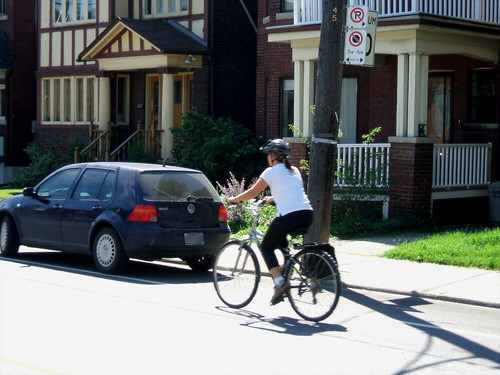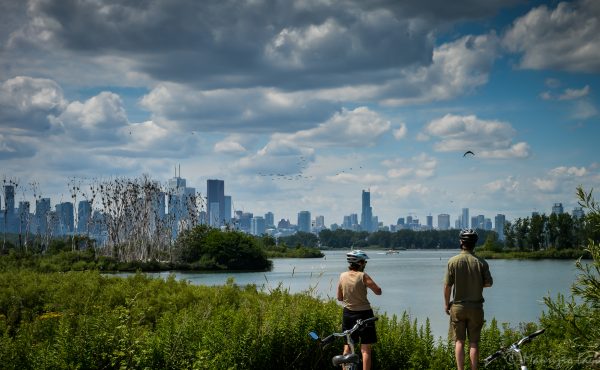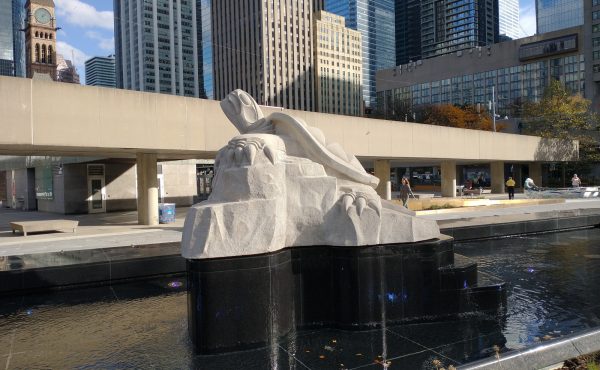Just three days into this year’s Bike Month, a damp May 28th was host to Bike Summit 2009, a day-long conference on cycling policy co-hosted by the Toronto Coalition for Active Transportation (TCAT) and the Clean Air Partnership. International and local presenters covered everything from bike parking to economic and health improvements, sharing perspectives and recommendations that could greatly improve our city’s cycling potential. Spacing will revisit and follow up on some of these ideas, perspectives, and words of two-wheeled wisdom, in hopes of continuing this momentum and encouraging Toronto to actually reach some of the best practices presented at the summit.
![]()
I thought the above photo rather apt, as a pretty basic don’t in bike-friendly street design. This is Annette Street. The small, predominately residential, west-end strip that has been home to all sorts of controversy, confusion, and convolution around the implementation of new bike lanes — a saga which seemed to see an innovative community advocacy organization come out on top. While it’s been a few weeks since the bike route was finally painted in, unfortunately, the pavement painting folks and the parking signage folks seem to be out-of-synch. Certain patches of the Jane to Lansdowne route have had parking signs appropriately changed, meanwhile other blocks seem arbitrarily left parking-oriented, allowing cars, like the one above, to sit leisurely (and legally) in the way of safe biking along this new route. Now with the city-workers’ strike, it’ll be another delay before the signs are changed and west-end cyclists can enjoy Annette as a safe, consolidated, well-designed bike route. And all this ironically in time for this year’s Bike Blitz on cyclist safety.
In contrast, panelists at the Bike Summit session, New Approaches to Street Design, had all sorts of insight as to smart approaches in designing multi-use infrastructure. Joshua Benson of the New York Department of Transportation shared stories from the Big Apple’s much-buzzed-about new bike facilities; while Norma Moores of IBI Group and Association of Pedestrian and Bicycle Professionals discussed signage, pavement markings, and other indicators that work best in Canada; and the city’s Nigel Tahair swung it back to a local focus, discussing cycling and transit design for Toronto’s waterfront.
Some key themes resonated throughout, including:
- 1. Out with cookie-cutter street design. Bike-friendly designs must be street-specific. While we may be influenced and inspired by innovative designs in cities like New York and Copenhagen, the best lesson we can learn from them is to consider a diversity of design ideas that best adapt to the realities of our own streets. This means thinking about their aesthetic, safety, and geographic conditions, as well as taking into account competing interests specific to the locale.
- 2. Intersections are key. Since the vast majority of cyclist fatalities and injuries take place at intersections, this is where the most creative planning needs to take place. Moores has been working with the Transportation Association of Canada on an updated version of their 1998 Bikeway Traffic Control Guidelines for Canada, conducting various studies as to what kind of signage and pavement indicators are most effective. This includes design ideas for separate bike crossings, combined crossings, and bike boxes (an area where cyclists wait ahead of car traffic).
- 3. Cyclists should not be an afterthought. Along with all other forms of street-use, whenever possible cycling must come into consideration at the outset of the design process. This way our transportation planning is better consolidated and coherent. This means, of course, making sure policy is set up to support multi-use street design.
Sorry, Annette Street, you may have missed out on some of the insights these panelists had to offer. But with all kinds of new bike infrastructure purportedly going in by 2012, let’s try to treat some of Toronto’s other streets with the ingenuity and respect they (and their various traversers) so deserve.
Photo by Emma Feltes





17 comments
Sounds a bit vague and general, I can’t get a sense of anything new we might learn from the panelists.
Another day another biking post on Spoking/wire.
Um, Glen, you know that’s one of the big things we’re into here, right? Do you point out that the Sunshine Girl keeps appearing in the Sun, everyday?
I know Shawn, I’m just joking around. It just seems that, as of late, a disproportionate number of posts have been on cycling. Its weighting in the “urban landscape” is not 25%.
It’s June, yo. That must be it.
“Its weighting in the “urban landscape†is not 25%.”
Not *yet* 25% Glen. Just you wait.
Title of this article is “New approaches to street design” but street design has to work for all involved… not just for pedestrians, or just for cars, or just for cyclists. I know that some of the posters on this site are “fans” of the reconstructed section of Lansdowne between Bloor and College. But I’m sure than none of these people actually use this stretch of road other than to drive or bike through. A group of Urban affairs students who actually came to the site acknowledged that the reconstructed east side of the street was disaster in terms of pedestrian friendliness (narrow sidewalk right next to a busy stretch of road). I’ll also point out that while this section of Lansdowne was narrowed, the remaining travelling lanes were widened — which encourages vehicles to go well over the speed limit. The only safe section of the street is the side that has the permanent parking bays… But of course I know this only matters to people who live on this stretch of road, rather than to people who only pass through.
In terms of what street design come to pass, I really think it comes down to who has more clout. (Clearly, the working class, immigrant people on Lansdowne don’t have any clout with this City Council.) I find it interesting that the merchants on Annette LOST their argument to keep street parking. In contrast, on Roncesvalles, where we are see a very expensive narrowing, the merchants were able to maintain parking on both sides of the road (successfully arguing that it is vital to their business). Funny how the Annette merchants were lambasted for voicing the same concerns.
Sorry if I sound like a squeeky wheel on the Lansdowne issue but I really think a lot of people don’t have any sense of the impact of some of the changes they propose and would see things differently if they actually lived on the stretches of road they comment on.
I disagree Sam. I lived on this strip, rode my bike, took transit, walked, etc. It is 10 time better than it was before. There seems to be no increase in speed, while at the same time it has made it better for the bus route since there is less stopping of traffic due to the parking.
I don’t think this was a working class not having clout issues. There were a tonne of residents who just parked on the street instead of using their garage: those spaces had become storage for items other than cars. Also, the residents who protested the fixing of the street used the worst excuses and examples to denfed their position. Things like the bulb outs for fire hydrants so no cars would park in front of them were cited as examples of purposely slowing down fire trucks. Their literature was full of half-truths and at time outright lies.
The stretch of Lansdowne between Dundas and Queen is nearly the exact same design but implemented 10 years ago. The street was bare of trees but is now tree-lined and pleasant to walk on.
As for Roncy, there were studies done that showed that a reduction in parking would not harm any business and that there was more than enough parking available at any given time. Its a complete fallacy that businesses are hurt by reduced parking (a total elimination of parking would be harmful, no doubt). I don’t have the study handy, but a US university did 4 studies on dense areas in SF, NYC, Chicago and LA (i think) and each showed that drivers only go to 1.25 stores in an area in one trip, while walkers and bikers go to 4 or more stores per trip. Its why shopping areas all over Europe pedestrian those places.
Sorry Mathew,
You may disagree… but I don’t think your observations add up. You may have “lived” on this strip but it doesn’t sound like you do anything other than pass through these days.
If you do live on this stretch of road, you will notice that any children playing on the road are on the WEST side protected by the buffered cars. Anyone who has kids knows that the east side is a much less safe strip of road that in was before. There was one woman who lived on this street who was VERY vocally supportive of the project… and then found out that the strip of boulevard the City was putting in was going in between the sidewalk and the private residences…In other words, it would not buffer pedestrians from the road. (South of Dundas, the boulevard is between the road and the sidewalk — a HUGE difference in terms of pedestrian safety). Will also point that after the reconstruction, this woman’s mother acknowledged flatly that the reconstruction made her feel much more concerned about her grandkids playing outside.
Regarding the points I made about Roncy, I’m not sure what study you are referring to BUT the bottom line is that those merchants WON the fight to maintain parking on both sides whereas the Annette merchants did not. (In any cases, many of these studies are dependent on variables that are very case specific and cannot merely be extapolated to justify actions regarding other sites.)
Jane Jacobs frequently made the point that people who actually live in an area are sensitive to changes that so-called experts or those who merely pass through are not. Does that mean those who live along a stretch get to call the shots? No, I don’t necessarily think so… but I do think there concerns shouldn’t merely be brushed off because they are unpopular or not trendy.
In any case, whether you agree or not with the changes made to Lansdowne, someone who does identify themselves as civic-minded would not find it acceptable that the changes to the street were made on the basis of a questionable “door to door survey” conducted by local Councillor Giambrone, while changes on other streets require a much more extensive consultation process. Bottom line is that the process on Lansdowne received less consultation than implementation of a public toilet in Dufferin Grove Park. I think issues of class, ethnicity and immigrant status had a huge part to play in why some areas get extensive consultation… and some do not.
I don’t know how living on the strip for years somehow disqualifies me from making observations on it. I lived on Lansdowne, used it every which way, experienced it. What else do you want?
I believe you live in the area too, but if you don’t live on Lansdowne, does that make your observations moot too? I would never suggest that. My experience is just as valid as the concerned grandma.
Using your logic, I hope you made no comments or any observations on the Jarvis redesign since you don’t live there.
Streets are used by both residents and outsiders. The Lansdowne opposition was purely based on keeping the status quo, which was a disaster. The street isn’t perfect but has become much better. I wish there was a boulevard on the east side, but its not nearly as bad as you paint it. While you make good points about consultation, I’m not sure repaving a road and planting of trees needed as much consultation as the neighbourhood wanted. I’m mixed on this process and what should have been done, including whether Giambrone deserved the flak he got. As a resident, I knew about this well in advance of the outcry and was surprised by the local reaction.
I’d be more concerned with councillors that side with resident to keep sidewalks out of their neghbourhoods. There are too many streets in the city where you have to walk on the road.
Mathew,
I didn’t say your address disqualified you from making comments…(please read my post more carefully), but I did say as a non-resident you may not be sensitive to certain conditions that residents are sensitive to. Sorry but Jane Jacobs made the same point. Regarding Jarvis, I would say that people living there DO deserve (more than others) to have their concerns addressed in a credible and open forum. (Which is a hell of a lot more than what happened on Lansdowne.) Does that mean the people on Jarvis should call the shots? No but there concerns should be rated more highly — especially with respect to what may be taken away from them. I don’t see what is so strange about this position.
If you were a resident on Lansdowne at this time, you should recall the letter that the Councillor sent to residents in Sept/06 alluding to further community consultation (which never came to pass and which really angered people). You should also recall the Nov/06 story in the local Villager in which the Councillor acknowledged that people on the street were “very unhappy” with the proposed redesign. Hence, I find it odd that one who professes to have been a resident can say they weren’t aware it was such a big deal for local people.
Regarding your insistence that Lansdowne is now 10x, sounds like hyperbole to me… but I am also going to assume that you are not making your comments as someone who is living with a young child living with you or an elderly parent. Otherwise, I would expect you to be a lot more sensitive to the dangers of having a narrow sidewalk right beside a busy arterial road.
Let me be very clear; personally, I am not upset that they took out a lane of parking out. BUT I am upset that a narrow sidewalk is right beside a very busy arterial road. I am not upset that they put in a boulevard with trees — but I am upset that this boulevard DOES NOT buffer pedestrians from traffic.
Are cars going faster? Yes, you would know that they are if you actually lived on the street. I take the bus frequently and drivers are now hitting speeds of 60k an hour — they were less able to do this previously because they had to drive more cautiously because of parked cars.
What a lot of so-called street redesign experts don’t want to acknowledge is that on a busy arterial road, parked cars represent a safety buffer, especially if there is no boulevard between the sidewalk and the road, or if the sidewalk is narrow. What the City did was take out a safety buffer on the east side. The boulevard might have been a good replacement buffer if it had been placed close to the road — but it wasn’t.
PS. Regarding your summary of what the protesters were concerned about, I think there is a big difference between understanding what people said, and misrepresenting what people said. I think you have done the latter. I don’t recall anyone saying that a sidewalk bump-out (on the west side where we now have permanent parking) would increase fire response times. But I do recall the fire department expressing concerns about the intention to narrow the street.
I realize this is a sensitive issue for me. I’ve moved on to other things… But i don’t like to see the history of it distorted, as I believe you have.
samg: On Annette, business owners “LOST their argument to keep street parking” because of the overwhelming number of area residents (i.e., people who live on or near Annette) who spoke in favour of removing some parking to put in a bike lane.
Sam: After this comment, I don’t want to go any further with this so that others can debate Annette etc, and that we don’t end up dominating this discussion.
But, you state:
“I did say as a non-resident you may not be sensitive to certain conditions that residents are sensitive to.”
I don’t know how much clearer I can be: I was a resident there for 3 years before and after construction. I now live 1km away from the strip and use Lansdowne frequently so I am aware of the traffic before, after and currently. I ride it, bus it, and walk it. I stop at the school for stuff, I have a friend on the street still. I may not live there 24/7, but Lansdowne is as close to a home street that I can have.
You also wrote: “I don’t recall anyone saying that a sidewalk bump-out (on the west side where we now have permanent parking) would increase fire response times. But I do recall the fire department expressing concerns about the intention to narrow the street.”
Well, I hope I still have the flyer handed out a YIMBY. It was 5 facts that were nothing but lies. I can get behind residents fighting city hall when its justified, but Lansdowne was not worthy of it. There were justified complaints, but the campaign that was raged was about as petty as I’ve seen it in Toronto.
As for the fire department: if you told them you were narrowing the 401 by a few inches they would have a problem with it. They like their big toys and won’t consider buying trucks for the narrower parts of the city. Fire trucks do more harm to urban design than any politician ever has.
I entirely agree, 8sml.
To expand, and further respond to samg, I’m not sure why you’d find it “interesting” that Annette merchants lost the street parking argument. If we’re talking about clout and we’re talking about Jane Jacobs, shouldn’t we find it, um, I don’t know, exciting (or at the very least, a propos) that a community advocacy group that is committed to public engagement and represents residents and business owners alike WON the argument for bike lanes? (I’m talking of course about world19.) Merchants comprise a small portion of Annette’s make-up (relative to say, Roncy), and while I agree that they shouldn’t be lambasted for voicing their concerns, their loss doesn’t strike me as all that “interesting.â€Â
And since authenticity seems to be an issue here: I’m a resident of Annette St and I work and play on Roncy. I bike, ttc, and stroll my way through, between, and along the two streets daily.
Mathew,
I am tired of the Lansdowne topic also. But I am even more tired of people (and media outlets) who intentionally or otherwise misrepresent what people’s concerns were. I am even more tired of people who like the redesign of the street and hence think the lack of public consultation that took place was perfectly Ok. Public consultation shouldn’t be about whether you (or I for that matter) like a project or not or whether your particular concerns have been dealt with. It should be about ensuring that all relevant stakeholders are able to have their concerns/issues addressed and dealt with in an open and transparent manner. Regarding Lansdowne, they were not. I can’t think of another road reconstruction project in this City that was budgeted at $2m, resulted in significant changes, and had virtually no public consultation to speak of.
On the basis of a letter and a news story in late 06, residents were lead to believe that local councillor Giambrone was committed to further public consultation before the project was approved — AND HE DID NOT FOLLOW THROW ON THIS. When residents took the story to the media, the improbable claim (with not a shred of evidence) was put forth that he did a door to door survey. (Months later, he would tell the Torontoist that he actually only spoke to about 1/6 of the households on the route.) During the court case that unfolded on this issue, the City did not even bother defending the claim regarding the survey. I’ll also point out that the court case was with respect to inadequate consultation NOT specific changes. Both Now magazine and the Star have misreported that the court case was to fight bike lanes. This is nonsense.
Regarding whether current residents might be more sensitive to certain changes, I still stand by this comment (though this is not an absolute statement). For example, you said above the reconstruction south of Dundas is virtually the same as north of College. As one who walks this stretch, I know that the absence of the boulevard between the sidewalk and the road, makes walking north of College a much more daunting experience.
Regarding your comments about the fire department, you may be right OR not. But the place to address these issues and others would have been in a series of community meetings — which take place IN ADVANCE on virtually all street projects over $1m that involve significant changes.
Mathew, no one is saying you can’t agree with the changes on Lansdowne… there is no right or wrong answer. But much of your post seems to suggest that you can overlook the public consultation that took place because you agree with the result. That’s not a very credible position.
P.S. Regarding the document at the YIMBY festival, I’m not sure what you are referring to. But I do know that it is very easy to say something is full of lies without providing any proof. That’s basically what you have done.
You wrote: “no one is saying you can’t agree with the changes on Lansdowne.”
Well, except for you. “I am even more tired of people who like the redesign of the street…”
One point I won’t concede is on the fire department. All you have to do is look at the city’s streetscape manual to see the widths of any new street designs: fire trucks trump all. I’ve spent 4 years on citizen’s committees at city hall and know these for a fact. We’d never be allowed to build Cabbagetown becuz of the Fire dept. and their ‘One size fits all’ mentality.
Mathew, twisting what people say is the easiest game in the book. But it isn’t civil behaviour.
In quoting me above, you cut off the last part of the particular sentence you quoted me on… thereby distorting what I said…
What I said was “I am even more tired of people who like the redesign of the street and hence consider it ok that proper consultation did not take place.”
Notice how the second part makes a big difference from what you said I said?
Please don’t twist what other people say. If you are going to quote them please include the qualifiers.
To Emma: I agree with your comments particularly with your observation that the presence of retail on annette is less substantial on Roncy and hence deserved less consideration. BUT i still think it is interesting (because it demonstrates talking out of both sides of ones mouth) that the City acknowledged the concerns of the Roncy merchants regarding the impact of taking away street parking, while with the Annette merchants they insisted these were groundless fears. Their fears are not groundless given the amount of BigBox outlets just a stones throw from that area. Certainly these fears shouldn’t trump everything, but they were not groundless (as you seem to recognize yourself).